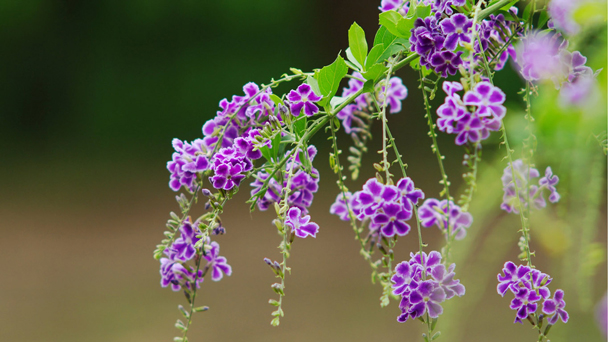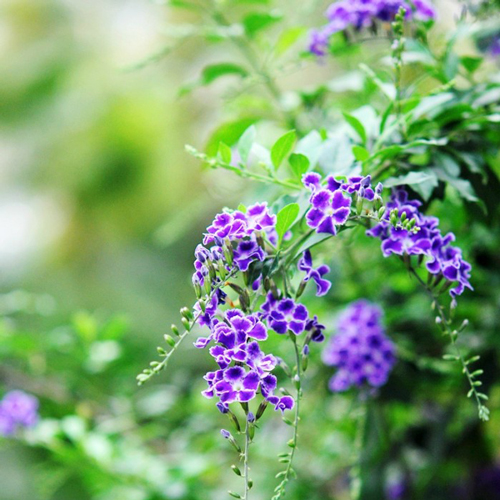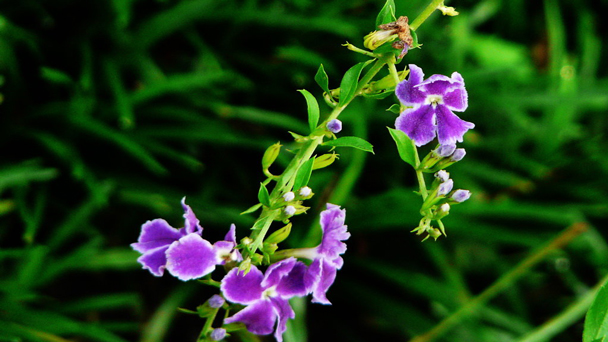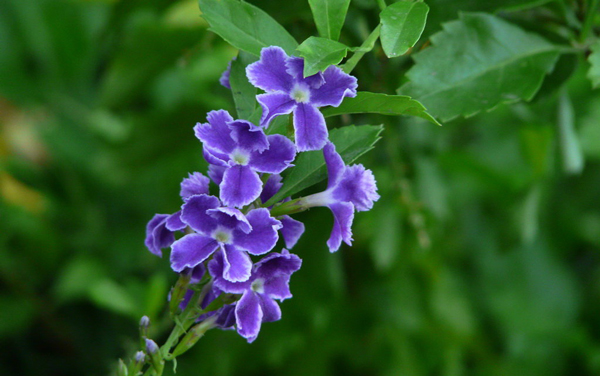Duranta Erecta Plant Grow & Care Guide
Written by Iris
Dec 06 2021

Duranta Erecta Plant, a rapidly growing shrub, can get 10 to 15 feet tall and over 5 feet wide. Duranta (Duranta Erecta) is listed as hardy to only zone 9, so here in Central Texas, it dies to the ground in winter in most gardens. Duranta Erecta plant is an easy-to-grow tropical flowering shrub, which is remarkably trouble-free and you'll have few chores other than watering them in dry weather.

Spread them over a sterile potting mix, pressing slightly into the soil and water moderately.
Ideally, the seeds should be placed at 70° degrees Fahrenheit (21° C) in constantly moist soil.
In the right conditions, germination will take place within 30 to 60 days.
Take the following steps to successfully propagate your duranta erecta plant:
When placed inside, you can keep it in front of a south-facing window that lets in plenty of light. Placing it in front of a south-east or south-west window without curtains would work better in case you want to control the height from getting too much for an indoor space.
Different plants have different water needs. Some plants prefer staying on the dry side, others like to be consistently moist. Refer to the plant label to check a plant’s specific requirements.
Ideally water should only be applied to the root zone - an area roughly 6-12” (15-30cm) from the base of the plant, not the entire plant. A soaker hose is a great investment for keeping plants healthy and reducing water lost through evaporation. Hand watering using a watering wand with a sprinkler head attached is also a good way to control watering. If the garden area is large, and a sprinkler is necessary, try to water in the morning so that plant foliage has time to dry through the day. Moist foliage encourages disease and mold that can weaken or damage Duranta Erecta plants.
To check for soil moisture use your finger or a small trowel to dig in and examine the soil. If the first 2-4” (5-10cm) of soil is dry, it is time to water.
'Alba': This plant forms clusters of white flowers.
'Golden Edge': This variety sports bright gold and green foliage.
'Sapphire Showers': This variety features vivid violet blooms with white edges.
Where to Grow Duranta ErectaHow to Grow Duranta ErectaDuranta Erecta Propagation from SeedsDuranta Erecta Propagation from Hardwood CuttingsHow to Care for Duranta ErectaDuranta Erecta Light RequirementsSoil for Duranta ErectaDuranta Erecta WateringDuranta Erecta Temperature & Humidity CareFertilizer Care for Duranta ErectaPruning Duranta ErectaDuranta Erecta Pests & Diseases CareVarieties of Duranta ErectaDuranta Erecta Care FAQIs Duranta Erecta poisonous?Can Duranta Erecta grow in shade?Is Duranta Erecta Toxic?
Where to Grow Duranta Erecta
If you have space you want to fill quickly, Duranta Erecta plants are a good choice. They grow rapidly, more than 25 inches a year. golden dewdrop has multiple stems that can grow from 8 to 15 feet tall with a round crown. Its drooping, vinelike branches can trail 10 to 15 feet wide. You may have to thin and prune a golden dewdrop regularly to prevent it from sprawling beyond the space you have in mind. If you grow Duranta plants as mounded bushes, give them at least 6 feet of room unless you want to constantly cut them back. Always sterilize pruning equipment before and after using it by wiping it with a cloth soaked in rubbing alcohol.
How to Grow Duranta Erecta
Duranta Erecta Propagation from Seeds
For propagating Duranta Erecta through seeds, collect the seeds from ripe fruits in the fall.Spread them over a sterile potting mix, pressing slightly into the soil and water moderately.
Ideally, the seeds should be placed at 70° degrees Fahrenheit (21° C) in constantly moist soil.
In the right conditions, germination will take place within 30 to 60 days.
Duranta Erecta Propagation from Hardwood Cuttings
In order to propagate Duranta Erecta you need to use a hardwood cutting. Hardwood cuttings should preferably be taken during early spring or early winter. The reason for doing this is to incur as little damage to the parent plant as possible.Take the following steps to successfully propagate your duranta erecta plant:
- After you have a hardwood cutting, trim it at a point where a leaf bud would grow.
- Leave at least two buds above the one at the bottom, and cut the top of the cutting.
- Strip off the leaf buds at the bottom, and take off the bark about two inches on top of this.
- Dip this end of the cutting into a rooting hormone and then place it into damp soilless mix.
- Cover the pot with plastic, making sure that the plastic does not touch the cutting itself but still covers the whole thing.
- Place this in indirect sunlight so it stays warm.
- Keep checking the pot for root development. You can remove the plastic and start treating it like an adult once the roots have developed.

How to Care for Duranta Erecta
Duranta Erecta Light Requirements
Duranta Erecta plants prefer sunny environments. They like plenty of light to grow to their full potential. If placed outside, they should be placed in the full sun. The plant can be grown in partial sun as well as in dry areas. This, however, causes its growth to be affected in a negative way.When placed inside, you can keep it in front of a south-facing window that lets in plenty of light. Placing it in front of a south-east or south-west window without curtains would work better in case you want to control the height from getting too much for an indoor space.
Soil for Duranta Erecta
A rich and organic soil, which drains well, is best suited to grow the Duranta Erecta plant. Soil that does not drain well is a major cause of root rot in many plants, and it is a risk no one should knowingly take.Duranta Erecta Watering
New Duranta Erecta plantings should be watered daily for a couple of weeks. After that, depending on the weather and soil type, watering Duranta Erecta can be adjusted to every two or three days. Clay soils hold moisture longer than sandy soils, so expect to water more frequently in sandy settings.Different plants have different water needs. Some plants prefer staying on the dry side, others like to be consistently moist. Refer to the plant label to check a plant’s specific requirements.
Ideally water should only be applied to the root zone - an area roughly 6-12” (15-30cm) from the base of the plant, not the entire plant. A soaker hose is a great investment for keeping plants healthy and reducing water lost through evaporation. Hand watering using a watering wand with a sprinkler head attached is also a good way to control watering. If the garden area is large, and a sprinkler is necessary, try to water in the morning so that plant foliage has time to dry through the day. Moist foliage encourages disease and mold that can weaken or damage Duranta Erecta plants.
To check for soil moisture use your finger or a small trowel to dig in and examine the soil. If the first 2-4” (5-10cm) of soil is dry, it is time to water.
Duranta Erecta Temperature & Humidity Care
In the summer: 64,4-71,6 ° F, the plant needs a cool wintering, when it is better to maintain a temperature of about 60,8 ° F. The plant prefers increased humidity, it is desirable to regularly spray the Duranta Erecta, but it can also adapt to relatively dry air.Fertilizer Care for Duranta Erecta
You can use general purpose fertiliser while planting Duranta Erecta. Make sure that the fertiliser is not in contact with the stem of the plant. You can use an organic fertiliser if the plant during winter. Additional fertilisers can be applied after pruning the plants after flowering. You can also use slow release liquid fertiliser. Slow fertilisers can promote abundant flowering and fruit formation.Pruning Duranta Erecta
The sprawling growth of the duranta erecta plant should be controlled by regular thinning and pruning. Pruning and thinning encourages bushy growth with more branches and flowers. These Duranta Erecta plants will continue to be more fabulous if the growth is controlled by thinning and pruning. It can be grown in containers on a porch, deck or on the patio. It can be grown as a Bonsai or as a decorative plant. Retaining a single trunk will create a tree. Pruning the tips regularly when the plant is young will help in producing a shrub. You can prune the plants annually after fruiting.Duranta Erecta Pests & Diseases Care
Outdoor golden dewdrop plants generally remain pest and disease-free. However, when grown indoors, they may be affected by whiteflies. The leaves and unripened berries of Duranta Erecta are known to be highly toxic to children and pets; they are fatal. However, the berries become edible once they get ripe. Songbirds (oscines) are known to consume unripe fruits without experiencing any negative effects. The colorful flowers and berries are highly attractive to butterflies and hummingbirds. Birds also play a key role in seed dispersal and are the major reason why sky flower plants become a fast-growing weed in many areas.
Varieties of Duranta Erecta
There are several varieties of Duranta that feature different color combinations. They include:'Alba': This plant forms clusters of white flowers.
'Golden Edge': This variety sports bright gold and green foliage.
'Sapphire Showers': This variety features vivid violet blooms with white edges.
Duranta Erecta Care FAQ
Is Duranta Erecta poisonous?
Duranta Erecta fruit is a small globose yellow or orange berry, up to 11 mm (0.43 in) diameter and containing several seeds. The leaves and unripened berries of the plant are toxic, and are confirmed to have killed children, dogs and cats.Can Duranta Erecta grow in shade?
This rapidly growing shrub can get 10 to 15 feet tall and over 5 feet wide. It's listed as hardy to only zone 9, so here in Central Texas, it dies to the ground in winter in most gardens. Duranta Erecta will perform best in full sun, but can take light shade.Is Duranta Erecta Toxic?
The Duranta plant has lovely berries that brighten up fall flower beds. However, these berries look tasty but are poisonous, and that’s a dangerous combination. If you have children or pets in your home, you might want to make sure they know about their toxicity or perhaps wait a few more years to plant it.Latest Updated
- Benefits of Bugleweed - 7 Science-backed Health Benefits
- Bugleweed Dangers & Side Effects - Is It Poisonous?
- How to Plant Evergreen Trees - What You Should Know
- When to Plant Evergreens - Grow Guide for Evergreen Trees
- 12 Wonderful Evergreen Shrubs for Your Garden
- 12 Popular Evergreen Plants with Pictures for Beginners
- When And How To Prune A Lilac Bush Like a Pro
- How to Grow & Care for Lilac Vine (Hardenbergia Violacea)
- Japanese Lilac Tree (Syringa Reticulata) Care & Propagation Guide
- Shumard Oak Pros and Cons - What to Know
Popular Articles
- Winter maintenance of Antirrhinum Majus
- How to Grow Terminalia Mantaly Tree
- How to Grow and Care for Crossostephium Chinense
- How to grow Antirrhinum Majus in spring
- Peristeria Elata (Dove Orchid) Profile: Info & Care Guide
- Underwatered Snake Plant (Sansevieria Trifasciata) - Signs And How To Fix
- How to Care for Brazilian Jasmine Plant (Mandevilla Sanderi)
- How to Grow & Care for Graptopetalum Purple Delight in Summer
- Rosa Chinensis (China Rose): Plant Growing & Care Tips
- How to Care for Baby Sun Rose (Aptenia Cordifolia)